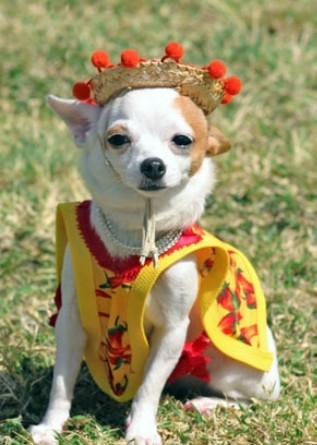
Business Pet care in Latin America Man's best amigo
商業 拉美的寵物喂養 人類最好的朋友
Profits from pooches are more than petty cash
狗用品市場的利潤可不是不容小覷
BLISS spreads across Lalo's face as his glossy black locks are blown dry by cooing stylists.
當寵物美容師一邊哄著Lalo,一邊吹干它烏黑亮麗的卷毛的時候,Lalo的臉上洋溢著幸福。
Dogs big and small are beautified for 100 pesos ($7.70) in the back of a perspex-walled van run by Fluffy Shower,
在塑膠墻面的貨車廂里,無論大狗還是小狗,美容費都是每只100比索(合約7.7美元)。
a mobile pet-salon that visits Mexico City's posh neighbourhoods to apply shampoo and ribbons to upper-class animals.
這輛車是一家名叫Fluffy Shower的流動寵物沙龍的,現在正在墨西哥城的富裕地區巡游,出售高級寵物的香波和鏈條。
The sharpest dogs sport green, white and red jerseys to mark Independence Day on September 16th.
最引人注目的狗穿著綠色、白色和紅色的運動衫,在9月16日慶祝獨立日。
Next month pet boutiques will sell Halloween pumpkin outfits and dainty witches' hats.
下個月寵物精品店還會推出萬圣節南瓜裝和精致的女巫帽。
Pet care is booming in emerging markets, as the growing middle class stops buying dogs for security (or dinner) and starts doting on them.
中產階級買狗不再是為了保衛或者食用,而是為了當作寵物,因此寵物保養在新興國家市場正蓬勃發展。
Nowhere has the fashion taken off as quickly as in Latin America.
而這種時尚在拉丁美洲的發展是最快的。
In the past five years spending on pet food and knick-knacks has risen by 44%, to $11 billion, according to Euromonitor, a market-research firm, which estimates that Chile has more pet dogs per person than any other country.
根據一家市場研究公司歐睿的調查,過去五年中,寵物食品和玩具的開銷增長了44%,達到了110億美元。
Latin pets may be the world's most fashionable.
該公司估計,智利是人均擁有寵物狗數量最多的國家。
As Mexico's rainy season tails off, dogs are stepping out of designer shoes to show off painted claws.
拉美的寵物應該是世界上最時尚的,隨著墨西哥的雨季漸漸結束,狗狗們脫掉時尚鞋子,開始顯擺它們的染色的爪子。
Rising incomes allow Latinos to treat mutts as members of the family.
隨著收入的增加,拉美人漸漸把狗狗們當成家庭成員了。
More young people are living alone and putting off marriage, choosing pets for company instead.
越拉越多的獨身年輕人推遲婚姻,選擇寵物作為自己的伴侶。
These "pet parents" indulge their animals as if they were children, says Emily Woon, Euromonitor's pet-care supremo, who reports that Latin America has been the "star market" of recent years.
歐睿寵物保養權威人士艾米麗·伍恩說,這些"寵物爸媽"們對寵物們溺愛地像自己的孩子一樣。據她所說,近年來,拉美已經成了"明星市場"了。
Latinos are especially fond of dogs, which are costlier than cats, but superior in every respect.
拉美人特別喜歡狗,盡管養狗比養貓要貴,但是在各方面都比養貓好。
Whereas in Europe the dog- and cat-food markets are equal, in Latin America dog food outsells cat food by nearly six to one.
在歐洲,貓狗食品市場份額相等,但在拉美,狗糧的銷售差不多是貓糧的六倍。
There is room for growth.
這個市場還有擴大的空間。
Many Latinos still feed their pets table scraps: three-quarters of Mexican hounds make do with leftover bits of burrito.
許多拉美人還是在用剩飯剩菜來喂寵物:四分之三的墨西哥獵犬都在吃墨西哥玉米煎餅的殘渣。
Billboards around Mexico City's parks urge owners to switch to Pedigree and other brands of delicious packaged pet food.
墨西哥城的公園里到處都是廣告牌,力勸寵物的主人改用寶路或者其他名牌包裝的可口寵物食品。
Glitzy pet superstores, which account for more than a fifth of pet-product sales in America and Canada, barely exist south of the Rio Grande.
在美國和加拿大,琳瑯滿目的寵物超市占了寵物產品銷售量的五分之一以上,而在格蘭德河以南卻十分罕見。
The most popular outlets are still small, independent pet shops, which retain customers by offering credit.
最流行的經銷店還是規模小、單獨的寵物商店,并通過賒購來保留客戶。
But the superstores will come. And when Latin animal-lovers can buy a full range of food, toys and veterinary services in one place, life could become even more luxurious for Mexico's privileged pets.
但是大型超市還是會出現的,如果拉美的動物愛好者在同一個地方購買所有寵物食品、玩具和醫用護理設備,那么墨西哥高級寵物們的生活將會更加奢華。











